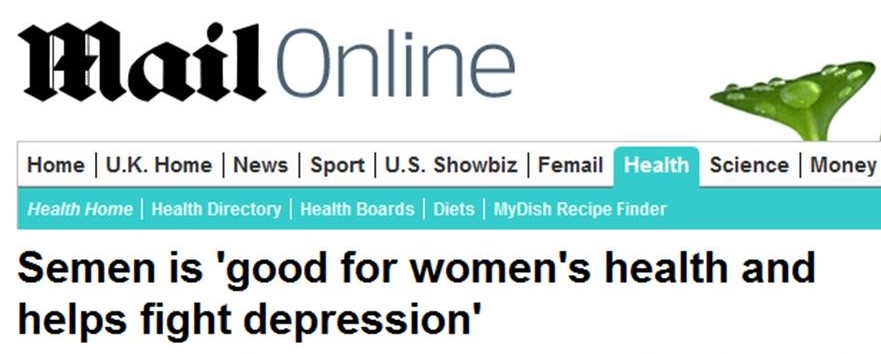Why The Daily Mail Is A Terrible Source For Sex News
July 8, 2013 by Justin Lehmiller

One of the reasons I started this blog is because I saw too many media reports about sex research that were sensationalized, misleading, and (in some cases) just plain wrong. In response, I have sought to create a resource for the public that provides an accurate and unbiased look at the science of sex. If there’s one media outlet that I wish would take a page from my book, it has to be The Daily Mail. I frequently come across sex headlines from them that make me cringe. Below, I take a look at five of their worst headlines of all time and clarify what the research actually says.
1. Casual Sex Makes You Depressed and Anxious, Finds New Study. – This is a classic case of a journalist confusing correlation with causation. In other words, just because two variables are statistically associated does not mean that one is causing the other! Also, even if we assume there is a causal association, we cannot say which direction it runs. The study in question found that the more casual sex people had, the more symptoms of depression and anxiety they reported. However, rather than casual sex causing depression and anxiety (as the headline states), perhaps people who are more depressed and anxious to begin with just have more casual sex (e.g., perhaps people with low self-esteem or attachment anxiety have more casual sex as a way of trying to feel better about themselves).
2. Semen is “Good for Women’s Health and Helps Fight Depression.”– Before we talk about the problems with this article, it should be clear from these first two headlines that the Daily Mail presents a confusing and inconsistent portrait of human sexuality. Sex causes depression but semen helps fight depression? What kind of sense does that make? OK, as for the article itself, the journalist describes a study in which it was found that female college students who had unprotected sex reported fewer symptoms of depression than women who used condoms. So this study didn’t even look at semen exposure—it only looked at condom use habits! Clearly, this headline is more than a little disingenuous. For a more elaborate look at the problems with this study, see here.
3. Teenage Sex “Leads to Bad Moods” in Later Life. – Based upon this headline, you might reasonably presume that the researchers followed people over time to determine whether teenage sex is linked to later mood changes. However, this article does not reveal until the fourth paragraph that the research was based upon hamsters, not humans! That’s right—hamsters. For a more detailed discussion on the shoddy reporting of this study, see here.
4. Is Sex and the City Responsible for the Demise of Pubic Lice? Doctors Say Bikini Waxing Made Popular By the Show has Caused Cases to Plummet. – Here’s an important lesson to any aspiring journalists: just because something was said by a doctor does not mean it is true or that it is worthy of an international news headline. Even doctors confuse correlation and causation sometime. While it’s true that reported cases of public lice declined in the years following an episode of “Sex and the City” about bikini waxing, we cannot point to the show as THE reason there are fewer lice today (e.g., maybe fewer cases are being reported because people are now getting over-the-counter treatments instead of visiting their doctors to get rid of pubic lice). But that didn’t stop the Daily Mail from publishing this gem of a quote from a dermatologist:
“In popularising hair removal Carrie Bradshaw and co have contributed to ridding humanity of [a] pest that had plagued humans for millions of years. Sadly there isn’t an Emmy for that.”
Oh my. And the worst part is that bikini waxing, which the article describes several times as being “popular” and “trendy,” actually isn’t nearly as common as the article implies. For example, in a study of over 2,400 U.S. women who were surveyed about their pubic hair removal habits, only 5.7% of women aged 18-24 reported having waxed at least some of their pubic hair in the past month [1]. Older women were even less likely to have done it. Thus, waxing can hardly be considered “popular,” let alone the sole cause of the decline in pubic lice.
5. Women’s Idea of the Perfect Man? A 6ft, £48k-a-year, beer-drinking meat-eater with an Audi. – There you have it—now we know once and for all what makes for the perfect man, right? Not so fast. This article is based upon a survey conducted by a clothing retailer (because they always conduct the best and most unbiased research, right?). Furthermore, the article tells us nothing about the nature of the sample (e.g., we don’t know how old these women were or where they were even from), so to imply that this is what ALL heterosexual women want in a man is extremely misleading. But the most offensive part is that the headline writer insisted on selectively presenting information from the study in a way that promotes the stereotype that women are superficial and care about a man’s wealth, status, and machismo more than anything. In reality, heterosexual women’s most desired traits in a male partner are his intelligence and personality (see here for scientific research on what women really care about).
Want to learn more about The Psychology of Human Sexuality? Click here for a complete list of articles or like the Facebook page to get articles delivered to your newsfeed.
[1] Herbenick, D., Schick, V., Reece, M., Sanders, S., & Fortenberry, J. D. (2010). Pubic hair removal among women in the United States: Prevalence, methods, and characteristics. Journal of Sexual Medicine, 7, 3322-3330.
You Might Also Like:

Dr. Justin Lehmiller
Founder & Owner of Sex and PsychologyDr. Justin Lehmiller is a social psychologist and Research Fellow at The Kinsey Institute. He runs the Sex and Psychology blog and podcast and is author of the popular book Tell Me What You Want. Dr. Lehmiller is an award-winning educator, and a prolific researcher who has published more than 50 academic works.
Read full bio >


